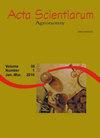Genotype selection based on multiple traits in cotton crops: The application of genotype by yield*trait biplot
IF 1.2
4区 农林科学
Q3 AGRONOMY
引用次数: 1
Abstract
In cotton crops, the cotton seed yield significantly contributes with the success of any cultivar. However, other traits are considered when an ideotype is pointed out in the selection, such as the fiber quality traits. The aim of this study was to applied genotype by yield*trait (GYT) biplot to a multi-environment trial data of cotton genotypes and selected the best genotypes. For this end, thirteen genotypes from nineteen trials were assessed. Seven traits were evaluated [cotton seed yield (SY), fiber percentage (FP), fiber length (FL), fiber uniformity (FU), short fiber index (SFI), fiber strength (FS), and elongation (EL)] and residual error variances structures [identity variance (IDV) and diagonal (Diag)] were tested by bayesian information criterion. After, the REML/BLUP approach was applied to predict the genetic values of each trait and the selective accuracy were measured from the prediction. Then, the GYT-biplot were applied to the data. For SP and SFI traits, the model with Diag residual variance was indicated, whereas for SY FL, FU, FS, and EL traits the model with IDV residual variance demonstrated the best fit to the data. Values of accuracy were higher than 0.9 for all traits analyzed. In the GYT-biplot acute angles were find for all traits relations, which means high correlation between the yield*traits combination. Besides that, the correlation still can be seen in the GYT-biplot, as shown by the magnitudes of the angles between the pairs Yield*FU-Yield*FS and Yield*FS-Yield*EL. Also, the GYT-biplot indicates the genotype G4 with the best performance for Yield*FS, Yield*SFI, Yield*FU, Yield*FL, and Yield*FP combined. The genotypes G4, G1, G13, G8, and G9 represent those genotypes with yield advantage over the other cultivars. Then, the genotype G4 combines all desirable characteristics and demonstrate have large potential in the cotton breeding. The GYT approach were valuable and were highly recommended in cotton breeding programs for selection purpose in a multivariate scenario.基于多性状的棉花基因型选择:产量-性状双图基因型的应用
在棉花作物中,棉花种子产量对任何品种的成功都有重大贡献。然而,在选择理想型时,还要考虑其他性状,如纤维质量性状。本研究的目的是将产量*性状(GYT)双标图应用于棉花基因型的多环境试验数据,筛选最佳基因型。为此,我们对来自19个试验的13个基因型进行了评估。采用贝叶斯信息准则对棉花籽粒产量(SY)、纤维百分率(FP)、纤维长度(FL)、纤维均匀度(FU)、短纤维指数(SFI)、纤维强度(FS)和伸长率(EL)等7个性状进行评价,并对残差方差结构(identity variance, IDV)和对角线(Diag)进行检验。然后,应用REML/BLUP方法预测各性状的遗传值,并根据预测结果测量选择精度。然后对数据进行gyt双标图处理。对于SP和SFI性状,残差方差为Diag模型,而对于SY FL、FU、FS和EL性状,残差方差为IDV模型拟合最佳。所有性状的分析精度均大于0.9。在gyt -双图中,所有性状的关系均呈锐角,表明产量*性状组合之间具有较高的相关性。此外,从Yield*FU-Yield*FS和Yield*FS-Yield*EL对之间的角度大小可以看出,在gyt双图中仍然可以看到相关性。G4基因型在Yield*FS、Yield*SFI、Yield*FU、Yield*FL和Yield*FP组合中表现最佳。G4、G1、G13、G8和G9是相对于其他品种具有产量优势的基因型。G4基因型综合了所有优良性状,在棉花育种中具有较大的应用潜力。GYT方法是有价值的,在棉花育种计划中被大力推荐用于多变量情况下的选择目的。
本文章由计算机程序翻译,如有差异,请以英文原文为准。
求助全文
约1分钟内获得全文
求助全文
来源期刊

Acta Scientiarum. Agronomy.
Agricultural and Biological Sciences-Agronomy and Crop Science
CiteScore
2.40
自引率
0.00%
发文量
45
审稿时长
>12 weeks
期刊介绍:
The journal publishes original articles in all areas of Agronomy, including soil sciences, agricultural entomology, soil fertility and manuring, soil physics, physiology of cultivated plants, phytopathology, phyto-health, phytotechny, genesis, morphology and soil classification, management and conservation of soil, integrated management of plant pests, vegetal improvement, agricultural microbiology, agricultural parasitology, production and processing of seeds.
 求助内容:
求助内容: 应助结果提醒方式:
应助结果提醒方式:


